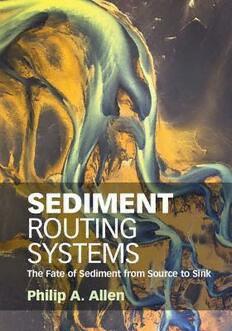
Sediment Routing Systems: The Fate of Sediment from Source to Sink PDF
Preview Sediment Routing Systems: The Fate of Sediment from Source to Sink
SEDIMENT ROUTING SYSTEMS This cutting-edge summary combines ideas from several sub-disciplines, including geology, geomorphology, oceanography and geochemistry, to provide an integrated view of Earth surface dynamics in terms of sediment generation, transport and deposition. Introducing a global view of fundamental concepts underpinning source-to-sink studies, it provides an analysis of the component segments which make up sediment routing systems. The functioning of sediment routing systems is illustrated through calculations ofdenudationandsedimentationaswellastheresponsetoexternaldrivers;withthefinal sections focusing on the stratigraphic record of sediment routing systems. Containing quantitativesolutionstoawiderangeofproblemsinEarthsurfacedynamics,thisbookis suitableforgraduatestudentsaswellasacademicandprofessionalresearchers. philip a. allen is Emeritus Professor of Sedimentary Geology at Imperial College Londonandaprocess-orientedEarthscientistwithaparticularinterestintheinteractions andfeedbacksbetweenthesolidEarthandits‘exosphere’throughthecriticalinterfaceof theEarth’ssurface.HehasreceivedtheRoyalSocietyWolfsonResearchMeritAwardfor 2006 to 2011 and the Lyell Medal from the Geological Society of London in 2007. He servedontheCounciloftheGeologicalSocietyfrom2008to2012,andwasSecretaryof theScienceCommitteefrom2009to2012. In this new book, Philip Allen has distilled a lifetime of insightful study of the Earth’s surface into a wide ranging and rigorous synthesis of planetary sediment processes. SedimentRoutingSystemsisthefirsttousetheideaofglobalsedimentrouting–‘following the sediment’ – to provide a framework for synthesis across environments and scales, to integrate the source and sink sides of the routing system, and to link geochemical and particulate fluxes. It manages to do this in a quantitative framework that is carefully formulated, accessible, and perfectly pitched in clarity and detail. Sediment Routing Systemsisalandmarkandmasterpiece;formanyEarthscientists,itwillbealltheyneed intermsofglobalsedimentdynamics. ChrisPaola UniversityofMinnesota Ifreadingthesedimentaryrecordisthedestination,thenthisbookisabrilliantcompanion fortheroad,rangingwidelyfrombedloadtoorganiccarbonandprovidingthoroughdetail on processes and methods at every turn. Philip Allen turns the sediment routing system fromPandora’sboxintoadynamicsource-to-sinkcascade. NielsHovius GFZGermanResearchCentreforGeosciences Sediment Routing Systems is the first complete, quantitative process-based account of sediment generation, transport and deposition in book format. In true style, ahead of anyoneelse,PhilipAllengivesanextremelythorough,comprehensiveviewofallprocess aspects of source-to-sink systems. This book combines theoretical with practical aspects and will be an obvious choice as an advanced text book in universities and as a key referencebookforprofessionalgeologistsdealingwithenergyandEarthsystems. OleJ.Martinsen ChiefGeologistandVicePresident,Statoil SEDIMENT ROUTING SYSTEMS The Fate of Sediment from Source to Sink PHILIP A. ALLEN ImperialCollegeLondon UniversityPrintingHouse,CambridgeCB28BS,UnitedKingdom OneLibertyPlaza,20thFloor,NewYork,NY10006,USA 477WilliamstownRoad,PortMelbourne,VIC3207,Australia 4843/24,2ndFloor,AnsariRoad,Daryaganj,Delhi–110002,India 79AnsonRoad,#06–04/06,Singapore079906 CambridgeUniversityPressispartoftheUniversityofCambridge. ItfurtherstheUniversity’smissionbydisseminatingknowledgeinthepursuitof education,learning,andresearchatthehighestinternationallevelsofexcellence. www.cambridge.org Informationonthistitle:www.cambridge.org/9781107091993 DOI:10.1017/9781316135754 ©PhilipA.Allen2017 Thispublicationisincopyright.Subjecttostatutoryexception andtotheprovisionsofrelevantcollectivelicensingagreements, noreproductionofanypartmaytakeplacewithoutthewritten permissionofCambridgeUniversityPress. Firstpublished2017 PrintedintheUnitedKingdombyTJInternationalLtd.PadstowCornwall AcataloguerecordforthispublicationisavailablefromtheBritishLibrary. LibraryofCongressCataloging-in-PublicationData Names:Allen,PhilipA.,author. Title:Sedimentroutingsystems:thefateofsedimentfromsourcetosink/ PhilipA.Allen,ImperialCollege,London. Description:Cambridge,UnitedKingdom;NewYork,NY:CambridgeUniversity Press,2017.|Includesbibliographicalreferencesandindex. Identifiers:LCCN2017014847|ISBN9781107091993(Hardback:alk.paper) Subjects:LCSH:Sediments(Geology) Classification:LCCQE471.2.A432017|DDC551.3/54–dc23LCrecord availableathttps://lccn.loc.gov/2017014847 ISBN978-1-107-09199-3Hardback CambridgeUniversityPresshasnoresponsibilityforthepersistenceoraccuracy ofURLsforexternalorthird-partyinternetwebsitesreferredtointhispublication anddoesnotguaranteethatanycontentonsuchwebsitesis,orwillremain, accurateorappropriate. Contents Preface pageix PartI AGlobalViewofSedimentRoutingSystems 1 1 SedimentRoutingSystems:FirstConcepts 3 1.1 HowSedimentRoutingSystemsFunction 3 1.2 TheSedimentCascade 11 2 TheGlobalCharacterofRiverBasins 20 2.1 MappingoftheTerrestrialSegmentofSedimentRoutingSystems 20 2.2 TopologyofRiverBasins 27 2.3 GlobalParticulateSedimentandSoluteDeliverytotheOcean 30 2.3.1 Run-off 32 2.3.2 ParticulateLoads 35 2.3.3 DissolvedSolids 44 2.4 ChemicalWeatheringFluxesAssociatedwithGlaciation 49 3 GlobalBiogeochemicalCycles 54 3.1 BiogeochemistryofWorldRivers 54 3.1.1 GlobalWaterChemistry 56 3.1.2 ChemistryoftheParticulateLoad 60 3.1.3 TheEstuarineFilter 61 3.2 TheFateofOrganicCarbon 62 3.2.1 ParticulateOrganicCarbon 63 3.2.2 DissolvedOrganicCarbon 65 3.2.3 BurialofOrganicCarbonandGlobalClimate 66 3.2.4 OrganicCarbonintheAmazonSedimentRouting System 69 3.2.5 OrganicCarbonthroughGlacial-InterglacialCycles 71 3.2.6 ParticulateOrganicCarbonatActiveandPassive Margins 74 3.3 NutrientFluxes 78 v vi Contents PartII TheSegmentsofSedimentRoutingSystems 81 4 TheCatchment-FluvialSegment 83 4.1 HillslopesandBedrockChannels 86 4.1.1 OutletSpacingofTransverseDrainageBasins 86 4.1.2 BedrockChannels 87 4.1.3 EffectofTectonicUpliftonRiverLongProfiles 92 4.1.4 Hillslopes 93 4.2 Basin-MarginFans 100 4.3 AxialversusTransverseDrainage 104 4.4 AlluvialRivers 108 4.4.1 FluvialGeomorphicElementsinSedimentaryBasins 108 4.4.2 Long-RangeSedimentTransportandDeposition 110 4.4.3 RiverPlanformPatternsandLongProfilesofAlluvialRivers 114 4.5 FloodplainsasSedimentStores 116 4.6 PalaeohydrologyofRivers 128 5 TheContinentalShelfSegment 131 5.1 DynamicsatRiverMouths 131 5.2 NaturalRangeofDeltaicandSubaqueousClinoforms 140 5.3 SimpleModelsofDeltaProgradation 141 5.4 SedimentTransportontheShelf 151 5.5 RiverPlumesandDispersalScaling 155 5.6 TheBottomBoundaryLayer 160 5.7 InteractionbetweenOceanCurrentsandCoastalWaters 166 6 TheDeepMarineSegment 170 6.1 SlopeMorphology 170 6.2 SedimentTransfertotheDeepSea:CriticalRoleofSubmarineCanyons 174 6.3 BasinPlainsandDeepSeaFans 176 6.4 Deep-WaterCirculation 184 6.5 RecordofGlaciationintheDeepSea 185 PartIII TheFunctioningofSedimentRoutingSystems 191 7 DenudationandSedimentation 193 7.1 RangeofTechniques 193 7.2 ControlsonSedimentYieldandErosionRate 196 7.2.1 ErosionRateinGlaciatedBasins 198 7.3 TheBQARTPredictor 202 7.4 EstimatesofErosionfromStrontiumIsotopeRatios 206 7.5 DenudationfromLow-TemperatureThermochronometry 211 7.5.1 FissionTrackAnalysis 211 7.5.2 HeliumDiffusion:(U-Th)/He 216 Contents vii 7.6 DenudationfromAnalysisofCosmogenicNuclides 218 7.6.1 Catchment-AveragedErosionRatefromCosmogenicNuclide Analysis 222 7.7 Sedimentation:Patterns,RatesandHierarchies 226 7.7.1 Life-SpanofSedimentaryBasins 226 7.7.2 SedimentationRatesandHierarchies 227 7.7.3 StratigraphicCompleteness 231 7.7.4 BedThicknessStatistics 236 8 DynamicsofSedimentRoutingSystems 240 8.1 MovingBoundaries 240 8.1.1 TheGravelFrontandGravelCline 240 8.1.2 TheShoreline 244 8.2 MassBalance 247 8.3 StochasticTheoryofParticleTrajectories 250 8.4 TowardsaVocabularyforTectonicLandscapes 256 8.5 TransientResponseswithinSedimentRoutingSystems 259 8.5.1 AlluvialRivers 261 8.5.2 HillslopeErosion 262 8.5.3 Catchment-FanSystems 263 8.5.4 GrowthofExtensionalFaultArrays 269 8.5.5 LateralGrowthofaFaultTip 273 8.5.6 KnickpointMigration 274 8.5.7 UnroofingofTectonicFolds 277 8.6 CouplingofTectonicsandSurfaceProcesses 279 8.6.1 OrogenicWedgesandForelandBasinSystems 280 8.6.2 CoupledTectonic-ErosionModelsofForelandBasinSystems 285 8.6.3 ArraysofContractionalFolds 288 8.7 TransformationofSignalsinSedimentRoutingSystems 291 PartIV TheStratigraphicRecordofSedimentRoutingSystems 295 9 SedimentProduction,EvolutionandProvenance 297 9.1 TheFormationofSediment 297 9.2 Precipitation,VegetationandErosion 304 9.3 Grain-SizeMixofSedimentSuppliedtoBasins 309 9.3.1 SimulationsUsingaVariableGrain-SizeMixintheSupply 313 9.4 Grain-SizeFractionationinSedimentRoutingSystems 318 9.4.1 DownstreamChangesinHydraulicGeometry 318 9.4.2 FractionationofGrainSizeDuringDispersal 319 9.4.3 Down-SystemFiningofGravelbySelectiveDeposition 323 9.4.4 EffectsofClimateChangeonGrain-SizeTrends 326 9.5 LinkingSourcetoSink:ProvenanceTools 330 viii Contents 10 SedimentRoutingSystemsandSequenceStratigraphy 335 10.1 InsightsfromQuaternaryStudies 335 10.2 OrbitallyDrivenSignalsinStratigraphy 343 10.2.1 EffectsofSeaLevelChange 346 10.3 AnalogueandNumericalExperimentsofSequenceArchitectures 349 10.3.1 AutostratigraphyResultingfromInternalDynamics 351 10.4 CyclesandtheGlobalSeaLevelChart 356 10.4.1 AnOrderedHierarchy? 356 References 364 Index 403 Preface By far the most powerful way to find out about Earth’s history is to study the sediments and sedimentary rocks comprising the stratigraphic record. With this in mind, Doyle and Bennett(1998)statedconfidentlythat StratigraphyisthekeytounderstandtheEarth,itsmaterials,structureandpastlife.Itencompasses everythingthathashappenedinthehistoryoftheplanet. ChrisPaola(www.esci.umn.edu/people/chris-paola)observedlyricallyandcautiously RachelCarsonwrotethat‘ThesedimentsareasortofepicpoemoftheEarth’.Unfortunatelythis poemiswritteninalanguagewedon’tunderstand. Part of this lack of understanding of the language of the epic poem of the Earth has its originsintheimperfectrecordingofeventsinthestratigraphicrecord,andparticularlyin thedifficultyofdecipheringwhattheEnglishpoetTennyson(1809–1892)calledthe‘long result of Time’, since the familiar processes responsible for the liberation, transport and depositionofsedimentarebestknownattheveryshorttimescalesofhumanobservation. AsJamesHuttonwrote(1785), itisnotinhumanrecord,butinnaturalhistory,thatwearetolookforthemeansofascertainingwhat hasalreadybeen. The other part of our lack of understanding derives from the difficulty of seeing the big picturewithallofitsfeedbacksandlinkages,whichallowsustoeffectively‘jointhedots’ (Allen,2014)(ch.1).Thisbig,integratedpictureisthatofthesedimentroutingsystem. Sedimentroutingsystemsarethedynamicalsystemsthatlinkthefateofsedimentfrom sourcetosinkandintegratetheprocessestakingplaceatornearthesurfaceoftheEarth, and the resultant depositional products, at the timescales relevant to the understanding of stratigraphy.Theyinvolvea‘cascade’ofsedimentfromprimarilyerosionalsourceareasto depositionalsinks,andthereforeareresponsibleforuplandlandscapesandtheirsediment andsoluteeffluxes,transportacrossthecontinentalsurfaceanddeliverytotheocean,and dispersalintolong-termdepositionalsitesinthedeepsea.Theprocessesactinginsediment routingsystemsthereforeshapeerosionalanddepositionallandscapesandextractsediment tobuildstratigraphy,theprimaryarchiveofthe‘epicpoemoftheEarth’. ix
